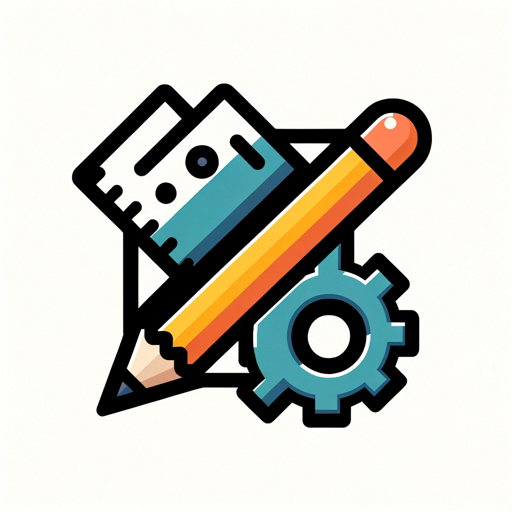Text to CAD-Text to CAD conversion tool
Transform text into precise CAD drawings with AI.
Describe a mechanical part for DWG conversion.
Generate DXF code for a gear with specific dimensions.
Related Tools
Load More
AutoCAD and CAD Expert
🔷#𝟏 𝐀𝐮𝐭𝐨𝐂𝐀𝐃 𝐚𝐧𝐝 𝐂𝐀𝐃 𝐀𝐬𝐬𝐢𝐬𝐭𝐚𝐧𝐭🔷

AutoCAD Master
Desktop-integrated AutoCAD expert

Technical Drawing
Expert in technical drawing, engineering graphics, and web-researched best practices.

AutoCAD Assistant
Your AutoCAD friend for learning about construction drawings and CAD

Computer-Aided Design (CAD)
A CAD design assistant, offering tools and guidance for prototyping projects.

Design Draft
Autodesk DWG-focused design assistant.
20.0 / 5 (200 votes)
Introduction to Text to CAD
Text to CAD is a specialized assistant designed to convert textual descriptions of mechanical parts and components into precise AC1032 DWG format files. The primary function of this tool is to interpret detailed textual descriptions, extracting specifications, dimensions, and design attributes to generate accurate CAD drawings. This capability is particularly useful for engineers, architects, and designers who need to transform their ideas or rough sketches into professional CAD files. For instance, if an engineer describes a complex gear mechanism with specific teeth dimensions and angles, Text to CAD can interpret these details and produce a DWG file that accurately represents the described gear.

Main Functions of Text to CAD
Textual Description to CAD Conversion
Example
An engineer describes a cylindrical part with a diameter of 50mm and a height of 100mm, including a central hole with a 10mm diameter.
Scenario
In this scenario, Text to CAD reads the description and generates a DWG file of the cylindrical part with the specified dimensions, ready for manufacturing or further design adjustments.
Complex Geometry Interpretation
Example
A designer provides a detailed description of a custom bracket with multiple curves, holes, and varying thickness.
Scenario
Text to CAD interprets the complex geometrical details and produces a DWG file that captures the exact design, allowing for precise fabrication and fit in the intended assembly.
Dimension Deduction and Reasoning
Example
A user describes a part without specific measurements but includes proportional relationships, such as 'a rectangular plate twice as long as it is wide, with a series of evenly spaced holes along the length.'
Scenario
Text to CAD deduces the dimensions based on the provided proportions and generates a DWG file that reflects these inferred measurements, facilitating the initial design phase where exact dimensions may not yet be finalized.
Ideal Users of Text to CAD
Mechanical Engineers
Mechanical engineers often need to create detailed CAD models from textual descriptions or rough sketches. Text to CAD assists in quickly converting these ideas into precise DWG files, streamlining the design and prototyping process.
Architects and Designers
Architects and designers can benefit from Text to CAD by transforming their conceptual descriptions into detailed drawings. This is particularly useful in the early stages of design when visualizing complex structures or custom components is critical.

How to Use Text to CAD
Visit aichatonline.org for a free trial without login, also no need for ChatGPT Plus.
Navigate to the website to start your free trial instantly.
Prepare your textual description.
Draft a clear, detailed description of the mechanical part or component you need in CAD format, including all relevant specifications and dimensions.
Enter your description into the Text to CAD tool.
Use the provided input field to paste or type your detailed description.
Review and confirm the generated DWG file.
Check the preview of the CAD file to ensure it meets your requirements, then confirm to generate the downloadable DWG file.
Download and utilize your DWG file.
Download the generated DWG file and use it in your CAD application for further design, analysis, or production work.
Try other advanced and practical GPTs
Coders
AI-powered coding made simple.

Stochastic Processes
AI-powered Stochastic Process Modeling

Kotlin for Android Studio Companion
AI-powered assistance for Kotlin development in Android Studio.

Financial Management Mentor
AI-powered Financial Management Made Easy

⭐️ Cocoa Twins® Bohemian Beauty Prompt Pro⭐️
AI-Powered Custom Art Creation

Aquinas
AI-powered insights for Catholic theology.

StudyGPT
AI-powered study assistance for students.

Age Estimator
Guess your age with a twist!

영어번역기
AI-Powered Korean to English Translation

AnatomyGPT
AI-Powered Assistant for Medical Learning

WooCommerce Expert
AI-powered WooCommerce development aid

Architec AI
AI-driven solutions for modern architects.

- Education
- Design
- Architecture
- Engineering
- Manufacturing
Frequently Asked Questions about Text to CAD
What types of descriptions can Text to CAD handle?
Text to CAD can handle detailed descriptions of mechanical parts and components, including specifications, dimensions, and design attributes. It is adept at interpreting complex geometries.
Do I need any specific software to use Text to CAD?
No specific software is needed to use Text to CAD. You only need access to a web browser to enter your descriptions and download the DWG files.
How accurate are the CAD files generated by Text to CAD?
The CAD files generated are highly accurate, adhering to the spacing and format requirements of the AC1032 standard. However, it is recommended to review the generated files for any necessary adjustments.
Can Text to CAD handle revisions or updates to descriptions?
Yes, you can input revised descriptions into Text to CAD. It will generate updated DWG files based on the new information provided.
Is there a limit to the complexity of designs Text to CAD can process?
While Text to CAD is proficient with complex geometries, extremely intricate designs might require additional manual adjustments after initial file generation.